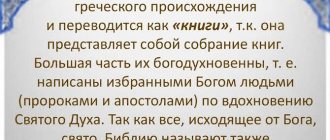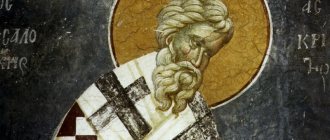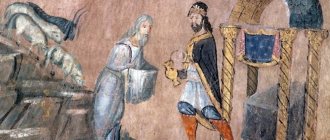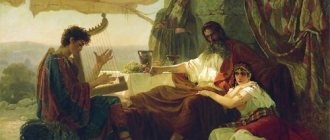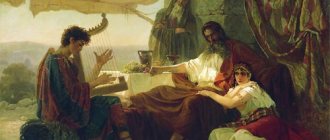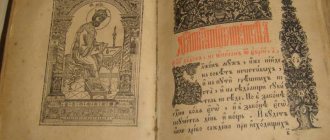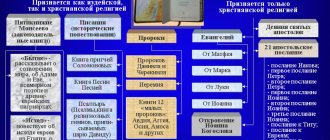Canon of the Books of Holy Scripture
The word canon (kanonos) in Greek literally means "reed ". In ancient times, measuring sticks were made from reeds, which were used for land surveying. Over time, this word began to generally mean a norm, measure, standard . In the Church, canons are the rules governing the life of a church organization . In relation to the Holy Scriptures, the canon is the list of books officially accepted by the Church that the Church recognizes as inspired . These books are called canonical. New books cannot be added to the canon of Holy Scripture and nothing can be taken away from it...
Depending on the time of writing, the books of Holy Scripture are divided into “two sections.” “Those Holy Books that were written before the Nativity of Christ are called the Books of the Old Testament, and those that were written after the Nativity of Christ are called the books of the New Testament . The word “ covenant (Heb.?)” means first of all “contract, agreement, alliance .” But since the promises of God were directed to the future and Israel was to inherit the benefits associated with them, the word was translated into Greek as diatheke , that is, “covenant or testament .”
Holy books of the Old Testament
The Old Testament is “ the ancient union of God with man ,” the essence of which is “ that God promised men a Divine Savior and prepared them to accept Him through gradual revelations, through prophecies and transformations . The very name “Old Testament” was introduced by St. ap. Paul (Heb. 8:13).
The canon of the books of the Old Testament “The Christian Church received ... from the Old Testament Jewish Church.” Although the canon of the books of the Old Testament was finally approved at the Council of Laodicea in 364 and the Council of Carthage in 397 , in fact the Church has used the Old Testament canon in its present form since ancient times. Yes, St. Melito of Sardis, in a Letter to Anesimius, dating from about 170, already gives a list of books of the Old Testament that almost completely coincides with that approved in the 4th century.
The books of the Old Testament " can be divided into the following four categories":
a) “ The books of the law, which constitute the main foundation of the Old Testament .” These books include: Genesis, Exodus, Leviticus, Numbers and Deuteronomy. “Jesus Christ himself gives these books the general name of the Law of Moses (Luke 24:44).”
6) Historical books, “which contain primarily the history of piety” : Joshua, Judges, Ruth, Kings, Chronicles, Ezra, Nehemiah and Esther .
c) Teaching books, “which contain the teaching of piety ”: the book of Job, Psalms, Proverbs of Solomon, Ecclesiastes, Song of Songs .
d) Prophetic books, “which contain prophecies or predictions about the future , and especially about Jesus Christ ”: the books of the great prophets Isaiah, Jeremiah, Ezekiel and Daniel , as well as the books of the twelve minor prophets Hosea, Joel, Amos, Obadiah, Jonah, Micah, Nahum, Habakkuk, Zephaniah, Haggai, Zechariah, Malachi .
In its editions of the Bible, the Orthodox Church places several non-canonical books in the Old Testament : 1st, 2nd and 3rd Maccabees, 2nd and 3rd Esdras, Tobit, Baruch, Judith, the book of the Wisdom of Solomon, the book of the Wisdom of Jesus, Son of Sirach . Non-canonical books are recommended by the Church for edifying reading and enjoy great religious and moral authority. According to St. Athanasius the Great, these books “are appointed by the Fathers for reading by those entering the Church.”
The formal feature that distinguishes non-canonical books from canonical ones is the language in which these books reached p . All the canonical books of the Old Testament have been preserved in Hebrew , while the non-canonical books have come down to us in Greek , with the exception of the 3rd book of Ezra, which has been preserved in a Latin translation .
In the 3rd century. BC, most of the books of the Old Testament were translated from Hebrew into Greek at the request of the Egyptian king Philadelphus Ptolemy . According to legend, the translation was carried out by seventy Jewish interpreters , which is why the Greek translation of the Old Testament was called “ Septuagiant .” The Orthodox Church assigns to the Greek text of the Old Testament no less authority than the Hebrew text. Using the Old Testament books, the Church relies equally on both the Hebrew and the Greek text.
Canonical books of the New Testament
Three reasons why it was necessary to define the New Testament canon:
Around 140 A.D., the heretic Marcion developed his own canon and set about disseminating it. To combat Marcion, the church needed to determine which canon of the New Testament was authentic.
Many Eastern churches used obviously counterfeit books for their services. This dictated the need for appropriate solutions.
In 303, Diocletian ordered the destruction of all Christian holy books. No one wanted to die simply for religious books. Christians wanted to know their canon.
The earliest list of New Testament books that completely coincides with the current one is given in 367 by Athanasius of Alexandria
in a congratulatory letter to the churches.
Shortly after Athanasius, a list of 27 titles of New Testament canonical books is given by Jerome and Augustine.
Polycarp
(115),
Clement
and other authors refer to the books of the Old and New Testaments with the words “as it is written in these Scriptures.”
Justin Martyr
(100-165) in his First Apology writes the following about the Eucharist:
“And on the day called Sunday, everyone who lives in cities and villages gathers in one place for a meeting, and reads there the writings of the apostles and prophets, as much as time allows. And when the reader has finished, the chairman of the meeting gives his instructions, inviting the listeners to imitate all this virtue.”
In the Dialogues with Tryphon, he quotes Holy Scripture with the words “for it is written.” Apparently, both he and Tryphon understand what the word “written” refers to.
Irina
(180 g). F. F. Bruce writes about the significance of his works:
“The importance of Irenaeus' testimony lies in its connections with the time of the apostles and with its ecumenical contacts. Irenaeus was raised in Asia Minor by Polycarp, a disciple of John. At 180 he became Bishop of Lyons. His writings testify to the inclusion in the canon of the fourfold Gospel, the Acts of the Apostles, Romans, 1 and 2 Corinthians, Galatians, 1 and 2 Thessalonians, 1 and 2 Timothy, Titus, 1 Peter, 1 Epistles, John, and also Revelation. In his Against Heresies, III, 2, 8, he makes it clear that by A.D. 180 the fourfold Gospel had become so generally accepted among Christians that it could be cited as an established fact, equally obvious , inevitable and natural, like the four cardinal directions on a compass or the four directions of the wind.”
Ignatius
(50-115 g); “I do not seek to command you like Peter and Paul, for they were apostles...”
Church Councils. ABOUT
They can be said approximately the same as in the case of the definition of the Old Testament canon (see Chapter 3, Council of Jabin).
F. F. Bruce writes that “when finally the church council - the Synod of Hippia - in 393 listed the 27 books of the New Testament, it only confirmed the influence that these books already enjoyed, in other words, it stated their actual inclusion in the canon. (The decision of the Synod of Hippia was confirmed four years later by the Third Ecumenical Council in Carthage).”
Since then, no one has seriously challenged the canonicity of the 27 books included in the New Testament by both Catholics and Protestants.
Apocrypha of the New Testament
Epistle of Pseudo-Barnabas (c. 70-79).
Epistle to the Corinthians (c. 96).
An ancient sermon, or the so-called Second Epistle of Clement (c. 120-140). Shepherd of Hermas (c. 115-140). Didache, Teaching of the Twelve (100-120). Apocalypse of Peter (c. 150). Acts of Paul and Thecla (170). Epistle to the Laodiceans (4th century?). Gospel of the Hebrews (65-100). Epistle of Polycarp to the Philippians (c. 108). Seven Epistles of Ignatius (c. 100).
There are many other New Testament apocrypha.
Chapter 4: The Reliability of the Bible
ACCURACY AND RELIABILITY OF THE TEXT
Introduction
In this part we will not talk about the Inspiration of the Scriptures, but only about their historical reliability.
The Bible must stand the same tests of reliability as any historical document.
In his Introduction to the Methodology of English Literary History, S. Sanders lists and explains three basic principles of historiography. This is a bibliographic test, a test of internal evidence and a test of external evidence.
Bibliography
- Fatas Cabeza, Guillermo: The End of the World
. 2001. History of Marcial Pons. ISBN 849537926 - Flaviano Amatulli Valente MAP: “Dialogue with Protestants.” Navarrete. Apostles of the Word. 1983
- Manuel de Tuya - José Salguero Introduction to the Bible, Volume I Library of Christian Authors Madrid, 1967
- Bob Stanley. "Canon of Holy Scripture" Jl 12, 1999
| Control of authorities |
|
- Data: Q51623
> All books >
"CANON OF SCRIPTURE"
Edward Whittaker
Definition
In relation to Scripture, the word "canon" usually refers to the list of books (or collection of books) of the Bible recognized as divine in origin and therefore authoritative. Kanōn is a Greek word meaning "straight rod" or "rule". In the New Testament it is translated "distribution" in 2 Corinthians 10:13,16 and "rule" in Galatians 6:16. It probably goes back to the Hebrew qaneh - “reed” (Ezekiel 40:3 etc.). In this meaning, the word was used for a list made in a column, and in church office work it represented a list of books of Scripture.
Synoptic books
The purpose of this study is to show how the canon of 66 books of the Bible was compiled. Modern critics are almost unanimous in attributing the formation of the Old Testament canon to the time of Ezra - about 500 BC, and the New Testament to the early councils of the Christian churches. Our task is to show the inconsistency of both of these conclusions. The Old Testament grew gradually under the guidance of the Holy Spirit as his book came out from under the pen of the next prophet; The New Testament followed the same rule throughout. God, through the prophets, gave instructions on how to preserve the books of both testaments for posterity - accordingly, Jews and Christians at one time had to take care of “their” sections. We will try to support this theory with sufficient evidence, which today's scholastic Bible critics rarely pay attention to. The place and authority of non-canonical books now classified as apocrypha will also be assessed; Particular attention will be paid to the reasons why they are excluded while the Roman Catholic Church, for some inexplicable reason, still includes some of them in its editions of Bibles. If the books of the Bible are truly divine, then it is natural to expect that they contain ample evidence of their truthfulness. For this reason, historical contradictory traditions are omitted from consideration. The difference between divine scriptures and human ones, true and false, will be shown so that there is no doubt left and any most picky critic can be satisfied with them. Apocryphal writings, as a rule, are empty words and smack of pathos both in content and stylistically. While the 66 books of our Bible are in perfect harmony both in doctrine and in moral standards, the Apocrypha absolutely fails to stand such a test.
Sequential compilation
High critics believe that the Old Testament was compiled and “canonized” by Ezra or Nehemiah, or even some of their contemporaries, around 500. BC. But neither in Scripture itself nor beyond it is there a hint of any worthwhile evidence for this theory. It is possible, however, to consider that the books were combined into a sequence and recognized as Scripture at the time when the era of the prophets ended, i.e. about the time of Ezra; it had three sections: the Law, the Prophets, and the Psalms (Luke 24:24). Here's what happened:
| TORAH | SKY | KETUBIM |
| Law | Prophets | Scriptures |
| Being | Joshua | Ruth |
| Exodus | Judges | Chronicles |
| Leviticus | Samuel 1-2 | Ezra-Nehemiah |
| Numbers | Kings 3-4 | Esther |
| Deuteronomy | Isaiah | Job |
| Jeremiah | Psalms | |
| Ezekiel | Proverbs | |
| 12 "minor" Prophets | Ecclesiastes | |
| Song of Songs | ||
| Lamentations | ||
| Daniel | ||
| 5 books | 8 books | 11 books |
\__________________________ __________________________/ V 24 books
But this classification, whenever made, has no bearing on the matter of divine canonization or recognition of each individual book. The Old Testament Scriptures themselves make it clear that they were added to the canon as they were written and had already acquired the characteristics of a whole by the time of Moses. Any Bible student himself can find confirmation of this view by “scanning” all 39 books and noting how later books refer to earlier ones - their heroes, events, laws and rituals. For example, the book of Malachi refers to:
In chapter 1 - on Esau and Jacob; 2 - on Levi and Phinehas; 3 - on Haggai; 4 - on Moses and Elijah.
Indeed, the references to earlier books in the book of Malachi must be almost three digits. The author counts more than thirty references to the Pentateuch alone. Even the second book of Exodus mentions persons and events identified in Genesis, for example:
In chapter 1 - on Israel going to Egypt; - details of Joseph's death; - on God’s providence to Abraham that his people would face disaster in “a land that does not belong to them”; 2 - for the Levi family; - on God's promise to Abraham, Isaac and Jacob; 3 - on the angel who appeared to them; 4 - to the ritual of circumcision and the death penalty for refusing it; etc. etc. throughout the book of Exodus.
Although the task is incredibly difficult, the arrangement of the Old Testament books in the correct historical order using this simple principle has become the best evidence of the successive addition of newly written books.
Continuity of books
In grammar, if a sentence begins with the conjunction “and,” the reader expects that what follows will be a continuation of what was written earlier. In Hebrew it is the word “we”, consisting of one letter “waw”. It can be translated as “and”, “now”, “but” and “then” according to the context. Significantly, this union opens many Old Testament books and is therefore a “built-in” indicator of continuity. Although individual books may have come from the pens of different prophets, they all have the common purpose of the Eternal Mind. An attempt to classify books on this basis leads to interesting observations. They are summarized in the table below. As you might expect, Genesis does not begin with “and.” The break before Deuteronomy may indicate a deliberate pause pertaining to a new beginning since this book was intended to regulate the life of the Jews after their occupation of the land of Canaan and was given to them a month before their entry into the Promised Land.
TABLE OF OLD TESTAMENT BOOKS BY THEIR SUCCESSION:
| Genesis Deuteronomy Exodus Joshua Levite Judges Numbers Ruth 1 Kings 2 Kings 1 Kings 2 Kings 1 Chronicles (from 10:1) 2 Chronicles Ezra Nehemiah (from verse 2) Esther |
On the other hand, the first four verses of Deuteronomy can be seen as introductory. In this case, the rule of continuity again applies - it is visible from Genesis to Esther. Further, additional explanations will be made for the remaining 22 books, but for now I have combined purely historical books.
Being
The book of Genesis is itself made up of books. After the introductory (1:1 to 2:3) chapters, it is divided into 10 parts, beginning with the words “This is the genealogy...” (2:4; 5:1; 6:9, etc.). The internal connection of eleven parts written on tablets or scrolls by ten or eleven prophets who were witnesses to the events they describe is visible. As it accumulated, the inspired Scripture that later became our book of Genesis was passed down through a select line of successors, so that by the time Moses wrote the books of Exodus, they were already one complete work to which Moses could refer in the order outlined above. This theory is simply fascinating and enchanting to try to apply it to Scripture, especially when you think that every generation of God's chosen people "since men existed" had its God-given portion of Scripture to guide them through life in the coming centuries. The idea of all the prophets being busy writing the book of Genesis for 25 centuries may seem fantastic, but Scripture itself lists Adam (possibly), Eve, Enoch, Methuselah, Lamech, Noah, Shem (possibly), Abraham, Sarah, Isaac, Jacob and Joseph. Here the reader is invited to conduct a scientific search himself to find the internal connections of this, nevertheless, rather extravagant theory.
Mosaic works
Omitting previously made references to the Mosaic writings relating to Exodus and Numbers, let us concentrate our attention on Deuteronomy - a most fertile object for attack by high critics. This book, restating the Law given by God on Mount Sinai, reconsiders it from the point of view of the new conditions of life upon arrival in the land of Canaan. It begins with the words “Beyond the Jordan...Moses began to explain this law, and said...” (Deuteronomy 1:5). The word "explain" literally means "to explain in writing" - from the Hebrew "baar", which means "to dig" or "to carve" (from a whole piece), as in the case of writing on stone tablets. After presenting the facts, it is confirmed that Moses wrote down the Law (a set of rules and punishments - 4:8) and gave it to the priests to be placed in the Ark of the Covenant (Deuteronomy 31:9,26). Before his death, Moses solemnly presented the original to the priests for preservation under the supervision of God. It was this document that was discovered by the priest Hilkiah during the renovation of the temple during the reign of Josiah about a thousand years later - it lay there neglected and forgotten by everyone throughout the dark period of idolatry (2 Deuteronomy 34:14). When Joshua succeeded Moses as judge of Israel, he was instructed by God to “be strong...and be careful to keep and do the law” (Joshua 1:7) and further: “Do not let this book of the law depart from your mouth; but study in it day and night... and you will prosper in your ways” (Joshua 1:8). This injunction is usually interpreted as a command to Navin in “daily reading.” The success that awaited him in fulfilling this covenant was to be crowned with the final conquest of the land of Canaan - the law was to serve as a guide in carrying out all operations. Thus we read that all decisions and actions were to be in accordance with the instructions given to Joshua by Moses (Deuteronomy 4:10; 8:31-35, etc.; 10:40; 11:12)
Historical books
There is strong evidence that in handing over the Law to the priests for safekeeping, Moses established a God-approved practice that all future prophets were to follow: “And Joshua wrote these words in the book of the law of God” (Joshua 24:26). Thus they were “entrusted with the word of God” (Romans 3:2). “And Samuel told the people the rights of the kingdom, and wrote it in a book, and laid it before the Lord.” (1 Samuel 10:25). The commandment in Deuteronomy 17:18 read: “When he sits on the throne of his kingdom, he shall copy for himself a copy of this law from the book that is kept by the priests of the Levites.” This is how “Testament” appeared. But one exception was made - for the young king Joash (2 Kings 11:12; 2 Chronicles 23:11; Isaiah 8:20). It is obvious that 1 and 2 Chronicles were written by prophets who were also priests, hence the emphasis on their own activities and the events in which they took part. Thus, only in Chronicles can one find information about the appointments of priests by King Solomon, the intervention of the priest Jahaziel in the affairs of the government of King Jehoshaphat, the desecration of the holy place by Uzziah and the protests of the priests, as well as about the reforms of Hezekiah and the Great Passover. In contrast, the four books of Kings, which were the historical books of the Jews, were written by people close to the royal court of both the whole of Israel and the divided Israel and Judah. In these six books, the prophets recorded information only about events that they were contemporary with. All this helps to connect the historical events described with very specific books, from the time of Isaiah onwards. A remarkable confirmation of this is the almost verbatim repetition of Isaiah 36:1-39:8 in 2 Samuel 18:13-20:19. But it goes on to say:
Nathan and Gad wrote about David - 1 Chronicles 29:29; Nathan wrote about Solomon - 2 Chronicles 9:29; Shemea wrote about Rehoboam - 2 Chronicles 12:15; Adda wrote about Abijah - 2 Chronicles 13:22; Isaiah wrote about Uzziah - 2 Chronicles 26:22; Isaiah wrote about Hezekiah - 2 Chronicles 32:32; Jeremiah wrote about Zedekiah - 2 Samuel 24:18ff (= Jeremiah 52); 2 Samuel 25:23,24 (=Jeremiah 40:7,8); Ezra wrote about Cyrus - 2 Chronicles 36:22 (Ezra 1:1).
If the idea suggested above is correct, then the priestly records of 1 and 2 Chronicles should present their records using the calendar of the ecclesiastical year, which began with the month of Nissan, while the books of Kings would use the civil calendar, which opened with the month of Tisri - six months later than the beginning of our year. This difference may partly explain the considerable difficulties in attempts to establish chronological harmony between the two collections of books under consideration.
Commentary on the Book of Job
Job “was a man...more famous than all the sons of the east” (Job 1:3); his lineage can be traced back to the time of Jacob (Genesis 29:1; Judges 6:3,33; 7:12, etc.) and he may even have been a descendant of Abraham's concubines, whose sons he "sent... from Isaac... to the east, to the land of the east" (Genesis 25:6). The phraseology of the historical chapters of the book (1,2,42) clearly reflects that of the times of the patriarchs. Job himself, according to the letter of James (5:10,11), was a prophet, and this is confirmed by his reference to “the days ... when the mercy of God was upon my tent” (Job 29:4). “The secret of the Lord” (Council of the Lord) is an idiom often used to describe divine revelation (Job 15:8; Psalms 24:14; Amos 3:7). Obviously, the prophetic gift was taken from him during his illness, but like all prophets, he left his Scriptures - not very voluminous, in all likelihood - which kept him in the ways of the Lord. This gave him the right to say: “I kept the words of His mouth more than my rules” (Job 23:12). The book says that it was written by Elihu, a descendant of the second son of Nahor, Abraham's brother (Job 32:2). As the narrative progresses, Elihu comments on the reaction of the stunned Job and his three friends to his reproach: “They were afraid, they answered no more; they stopped speaking... they stood still and answered no more” (Job 32:15,16). The idea deserves development, but besides the fact that through the books of Genesis and Exodus it is possible to trace the existence of close relationships between the clan branches of the patriarchs and their constant “concern” for the well-being of relatives, it is not even possible to establish who and under what circumstances included the book of Job in the canon of Scripture.
Text safety
It is remarkable that the long line of Hebrew prophets were “filled with the power of the Spirit of the Lord, with righteousness and steadfastness, to tell Jacob his transgression, and Israel his sin” (Micah 3:8), they never accused the people, rulers or priests of perversion or even the slightest change in what they wrote - “they were entrusted with prophesying in the name of the Lord.” And no matter how guilty the Jews were of stubbornness, idolatry and rebellion, they carefully monitored the preservation of the text, even to the point of counting the number of words and letters in the book, deducing the central word of the book, etc., to make sure that nothing added and nothing lost. Here is an example illustrating what has been said. In Judges 18:30, which talks about the descent of the tribe of Dan into paganism, the priest appointed to perform the false prayer is introduced as “Jonathan the son of Gershon the son of Manasseh,” when in fact Gershon was the son of Moses. It is obvious that the scribe, ashamed to attribute idolatry to the grandson of the great prophet, inserted an extra letter into the name of Moses - the letter of the Hebrew alphabet "nun", and thus Moses turned into Manasseh. But this was soon discovered, for later scribes reverently “took out” the letter “nun” from the word and placed it above the text. Since then it has been called the “case of the suspended letter.” The discovery of the Qumran scrolls in the 20th century has brought surprising evidence of the integrity of the Old Testament texts. Previously, the oldest Hebrew manuscript dates back to the 9th century CE, and the Dead Sea Scrolls collection, represented by all the books of Scripture except Esther, dates back to approximately 200-250 CE. BC. What is even more remarkable is that as the scrolls are deciphered, they invariably confirm the extreme authenticity of their known originals - there are extremely minor deviations that have neither factual value nor spiritual significance.
Non-canonical writings
The Old Testament contains several references to books not included in the canon of Scripture. When Israel won an important victory over the people east of the Jordan River, the fact was reflected in poetry (Numbers 21:14-18) and recorded in the Book of the Wars of the Lord (verse 14). Joshua's victory in the Valley of Aijalon (Joshua 10:12,13) and David's lamentation over the deaths of Saul and Jonathan are “written in the book of the Righteous” (2 Samuel 1:18-27). The Book of the Righteous One was thus compiled before the events described in Joshua 10: and presumably could have included the poetic verses of Moses (Exodus 15:1-18), Deborah and Barak (Judges 5), as well as Anna (1 Samuel 2:1-10). It is possible that the "Book of Wars" and the "Book of the Righteous" were identical and constituted a collection of Israeli Songs of Glory. In general, it is believed that Scripture was borrowed from non-canonical books, but in fact the opposite option is also possible - moreover, in accordance with our knowledge of the place and time of the ministry of the Israelite prophets - that the Songs of Glory were a collection of extracts from our canonical Scripture for secular use.
Christian prophets
There is an unfortunate tendency to diminish the scope and scope of the ministry of the early Christian prophets. Paul wrote that “You are no longer strangers and foreigners, but fellow citizens with the saints and members of God’s household, having been built on the foundation of the apostles and prophets, Jesus Christ Himself being the chief cornerstone, in whom the whole building, being fitted together, grows into a holy temple in the Lord.” (Ephesians 2:19-21). It would not seem excessive to say that he had in mind the Christian prophets (Ephesians 3:5). They were ministers completely independent of the apostles, although, presumably, the latter were also prophets - due to the high place the institution of the apostles occupied. But the prophets were second only to the apostles in “importance” (1 Corinthians 12:28) and possessed “better gifts” (1 Corinthians 12:31; 13:2; 14:1). As the moment required, God, acting through the prophets, gave the ecclesias a word of exhortation and revelation - both written and oral; -reminded of all previous prophecies and teachings; -directed the movement of missionaries; -gave “revelations” and “secrets” that were still hidden in the Old Testament; -transferred new blessings to encourage and teach growing communities.
"Received" and "notified"
When Moses compiled the first copy of the Law and gave it to the priests to be kept "at the right hand of the ark of the covenant" (Deuteronomy 31:9,26), he thereby established a tradition (with the knowledge of God) which was then continued in a new application by the Lord Jesus Christ through the Holy Spirit . Arguing for the resurrection of Christ, Paul wrote: “For I taught you from the beginning what I also received, that is, that Christ died for our sins according to the Scriptures” (1 Corinthians 15:3). Whether or not the questionable scripture can be identified with our New Testament cannot be established, but the apostle called it “my gospel” (Romans 2:16; 16:25). Perhaps he had this same gospel in mind in Galatians 3:1, where he addresses his readers, “O foolish Galatians! ... before their eyes Jesus Christ was depicted as being crucified among you.” This written gospel was Paul's chief authority and he continually turned to it. In the same letter to Corinth, Paul says about the Last Supper: “I received from the Lord himself what I also delivered to you” (1 Corinthians 11:23). In addition, he “conveyed” (“traditions”) to them in writing the creed which they had hitherto adhered to as a common recommendation (1 Corinthians 11:2). In the preface, or rather the accompanying note, to the new Gospel, Luke said (Luke 1:2) that various versions of the accounts of “the events known among us,” which they believed unconditionally, “were handed down to us ... who were from the very beginning eyewitnesses and ministers of the Word " These latter may have been elders or prophetic ministers at Antiochus, for there is reason to believe that this was Luke's native ecclesia (Acts 11:20,26,27).
Authenticity
In apostolic times, ordinary letters and documents, as opposed to government correspondence, were transmitted through friends or fellow travelers. This method was widely used for correspondence between brothers. It was important, however, that inspired prophetic letters (the Scriptures) should be distinguished in some way from everyday correspondence—even from ordinary correspondence on religious topics, such as the personal memoirs of the Lord's servants. Some false brothers circulated counterfeit letters purporting to be from Paul (2 Thessalonians 2:2). To avoid such impostors, the brothers were endowed with the gift of miraculously distinguishing lies from truth (1 Corinthians 12:10; 14:29). With its help, they determined whether the “applicant” was actually endowed with the gift of God: “for many false prophets have gone out into the world” (1 John 4:1). The Lord spoke to the elders in Ephesus: “You have tested those who call themselves apostles and are not, and you have found them to be liars” (Revelation 2:2). And Paul instructed the Thessalonian brothers: “Do not quench the Spirit. Do not disparage prophecies. Test everything, hold on to what is good” (1 Thessalonians 5:19-21). Only after being assured of their proper endowment by God were they accepted by the ecclesia as inspired prophets. And then they were treated so “tenderly” and so ardently protected, as would have been done only with the tablets of the Ark of the Covenant. The secrets of the Lord God were now confided to spiritual Israel no less than to carnal Israel. In general, most of the messages can be loosely timed to the events described in Acts; In addition, “unplanned coincidences” arise that unite these events historically. This harmonious interaction exactly corresponds to the same phenomenon in relation to the Old Testament, where, according to God's plan, the works of the prophets are intertwined with the content of the historical books - Kings and Chronicles. Of great interest for the present study is the amazing fact that the messages mention events and sayings of the Lord, sometimes reproducing the corresponding passages of the Gospels with such accuracy that one may conclude that the writers are aware that the recipient has a copy of the Gospel in order to follow the author’s thoughts. For example, in 1 Thessalonians 5:2 Paul could say, “For you yourselves know it of certainty,” and then make numerous references to the Lord’s discourses given in Matthew and/or Luke. When Paul wrote in 1 Corinthians 7:10, “But to those who are married, I command not I, but the Lord,” and in verse 25, “I have no commandment of the Lord,” he meant primarily that they could themselves find guidance for action in the available they have the Gospels. In 2 Corinthians 8:18 Paul speaks of the brother he sent with Titus as being “commended in all the churches for his gospel.” The phrase would sound mysterious if you did not know that Titus's brother was Luke, whose gospel was already widespread. The absence of any mention of Titus in Acts may indirectly indicate a close relationship. In 1 Timothy 5:18, Paul says, “Do not muzzle an ox while it is threshing,” and Luke in 10:7 writes, “The worker deserves the reward of his labor,” both without making any reference to the sources. No doubt Timothy knew the passage from Deuteronomy by heart, but the quotation from the Gospel of Luke would certainly have confused him if he had not had a copy of the book. Paul confirms our reasoning in the next chapter by saying, “...whoever teaches otherwise and does not follow the words of the Lord...” - 6:3. The present author throughout assumes that John's Gospel was written before the Jerusalem Council (Acts 15) - this harmonizes well with the view of canon formation presented here.
Spreading
Jesus ordered the Apostle John to send the Apocalypse to seven churches in Asia Minor. The order in which the letters were composed exactly corresponded to the route of the person who delivered them. Having departed from Ephesus with six copies and having reached, with intermediate stops, the point of Pergamum, the most distant from the sea, he returned to Ephesus, now through Laodicea. (This does not exclude another interpretation, according to which the order of delivery corresponded to the subsequent decline in faith in these cities - Laodicea “distinguished itself” in this as much as possible. Two of Peter’s letters were addressed to Christians in the five provinces of Asia Minor (1 Peter 1:1; 2 Peter 3: 1) It is clear that the courier had to have enough copies of each letter to deliver them to each large church or the one that was located most advantageously geographically in relation to the rest of the ecclesias of the province.They were then responsible for the further distribution of the letters in their district. By the time Peter wrote his letters—the first of them not earlier than 65 C.E.—the number of ecclesias in the five provinces must have increased significantly. It is possible that the “seven churches of Asia Minor” were distributing letters in a similar way. In Colossians 4:16, Paul said: “When this message is read to you, then order that it be read in the Laodicean church; and the one from Laodicea, read it too.” The letter to the Ephesians was probably delivered by Tychicus (Ephesians 6:21,24).
Compilation of the canon
In the second letter (3:15,16) Peter writes: “Just as our beloved brother Paul ... wrote to you, how he speaks about these things in all his letters, in which there are some things difficult to understand, that the ignorant and unstable, to their own destruction, they transform it, like other Scriptures.” The passage is very explicit because the past tense of the verb “wrote” indicates that Paul’s death unexpectedly interrupted his prophetic ministry, and also indicates that both Peter and the ecclesias of all five provinces had already accepted all of Paul’s writings as “other writings,” i.e. e. received the status of divinely inspired. This means that by that time each ecclesia had a fairly extensive “ecclesial library” of Christian literature. Acts reflects the rapid growth of churches; this is evident from phrases such as “In these days, while the disciples were multiplied...” (6:1ff. 7; 9:31). For comparison, another motive sounds: “And the word of God increased...” (6:7), “The word of God increased and spread” (12:24) and “With such power the word of the Lord increased and became powerful” (19:20). According to Greek grammar and the context of what was written, these passages certainly mean that the "revealed Word of God" assumed great proportions and multiplied in the number of copies in circulation. All three passages talk about increasing the number of copies of God's Word; the second of these ironically contrasts with the previous verse (12:23), where Herod “was eaten by worms and died”; the third concludes (19:19) in its content, where the books of magicians and sorcerers were burned by the hands of the converts of the city of Ephesus. Consequently, as soon as the ecclesia appeared, it immediately felt the need to acquire the books of new Scripture - as they came out from the pens of the Christian prophets. The ecclesias that were lucky enough to have the originals no doubt took the trouble to reproduce the books to satisfy the growing need for them. There is a lot of evidence for the proposed view on the compilation of the canon, although not on the surface. From the very beginning, open readings of Scripture have been an essential part of ecclesial life, especially readily accepted by converts from Judaism, because they were familiar with the similar practice of reading in the synagogues (Acts 13:15; 15:21). Paul taught Timothy, “Till I come, keep yourself busy with reading, instruction, teaching” (4:13), i.e. pay attention to all types of spreading the Word, incl. and public speaking. Parts of both the Old Testament and the rapidly growing New Testament were read. All ecclesias sought to have copies of all new Scriptures as soon as they became available. By the time the gifts of the Holy Spirit were selected, all ecclesias owned the complete collection of the writings of the Christian prophets - exactly the same in content; they compiled a single canon of Scripture, which became known as the New Testament.
Apocrypha
Micah 3:6 says, “The sun will set on the prophets.” And when this happened, and the Scriptures were filled with the last book, it was recognized as the God-given canon. Even after the Greek translation of the Septuagint was completed—three centuries before Christ—not one of the Apocrypha was worthy of inclusion there. The Jews have always jealously guarded their precious heritage: “You shall not add to what I tell you, nor take away from it” (Deuteronomy 4:2). Over many centuries, the prophecies of the pre-Christ era, called by Paul the “old testament” (2 Corinthians 3:14), have not undergone any changes and now look the same as those 39 books 2,000 years ago. In parallel with the true Scripture, the number of books that were not inspired by God grew and were called apocrypha - from the Greek apokrupto, which means “hidden”, because. These books were considered by the priests unsuitable for public reading. Of these, the Book of Suzanne was considered the most vulgar. The entire collection includes 14-15 documents; some of them were recognized by the fathers of the early Christian church, and the Roman Catholic Church included the seven apocrypha in its Bible, which also included some additions to Esther and Daniel. Following the example of what was just told, new apocrypha began to appear - already on the themes of the New Testament. When the ministry of the Christian prophets gradually faded away and the corresponding gifts were taken away (towards the end of the first century), several false writings appeared. Now their authenticity could only be verified by inspired Scripture. Now it is not difficult to see the true motives for writing false testaments. Obviously, someone who had pretensions to the title of writer wanted to make up for the supposed loss of the above-mentioned letter to the Laodiceans by composing a new one - a fake one. But Jerome said: “everyone rejects him,” and Calvin wrote: “it was too obvious a fraud.” Paul mentioned that “Jannies and Jambres resisted Moses” (2 Timothy 3:8). But since these names are not mentioned in the historical book of Exodus, a certain enterprising scribe decided to fill the gap by compiling a book called “Jannies and Jambres” - it is mentioned by Origen and others. Likewise, the dispute between the archangel Michael and the devil over the body of Moses, recounted in Jude 9:, is not reflected in Deuteronomy, where the death of Moses is described, nor anywhere else. Another ingenious forgery writer decided to glorify his unnamed name by writing “The Ascension of Moses.” The Book of Enoch shares the same glory. It is generally accepted that Jude (verse 14) quotes this apocrypha when he writes “Enoch also prophesied about them..., saying: Behold, the Lord comes with ten thousand saints...”, i.e. it must have taken place before Christ. In fact, a closer look at the Book of Enoch quickly reveals the exact opposite: it contains many obvious allusions and entire phrases borrowed from the New Testament, most of the Gospels, including Jesus' reproachful words to Judas, as well as false teaching about fallen angels, immortality of the soul and ascension to heaven. It is not surprising that the apocryphal Enoch borrowed words, phrases and meaning from no less than the eleven verses of Jude. When the present author once borrowed Enoch for review, he could not shake the impression that he was looking over the shoulder of an unscrupulous swindler, watching as he, having laid out the Hebrew Scriptures and several books of the New Testament in front of him and, already with a pen in his hand, enthusiastically “teared” them into his thief's document.
Church cathedrals
It is generally accepted that church councils of the 2nd-5th centuries. AD determined the final composition of the New Testament. But enough has already been said that it was “legitimized” by Christ through the Holy Spirit, at those moments when individual books were written and handed over for safekeeping to those to whom they were addressed. And only later, when the apocrypha appeared after the gradual disappearance of the gifts of the Holy Spirit, doubts crept into the minds of unsteady believers. It was then that the bishops and their councils - a real hierarchy of heretics - decided to take matters into their own hands: they compiled catalogs of writings that were to be recognized as “fit for use.” The whole procedure was obviously groundless, because... God has provided an infallible criterion for discerning the truth of the holy books. The entire history of church councils is sad reading. But, thank God, we don’t have to focus on this nonsense, because... the canon was approved even earlier by Christian prophets, and we can completely rely on their inspired instructions.
Ratings
- Fatás Head, page 88.
- Metzger, p.7
- Metzger p. 40.
- Metzger, p.42
- Metzger pp. 134 and 137.
- Fatás Head, page 89.
- Fatás Head, page 87.
- Fatás Head, page 90.
- Altaner p. 144.
- Fatas Cabeza, pp. 88-89.
- Kalin, 2002.
- Davis, Glenn (2010), Development of the New Testament Canon, p. 1.
- Metzger p.203-205
- Metzger pp. 135-141
- Metzger 238
- Metzger 234-236
- Metzger pp. 241-243
- Metzger pp. 244-246
- 15001-1508
- KELLY, John Norman Davidson; Early Christian Doctrines; Pág. 53; Continuum; Londres, Inglaterra, 1958; ISBN 0-8264-5252-3.
- https://pt.m.wikipedia.org/wiki/IV_Baruque
